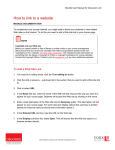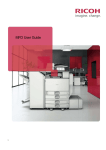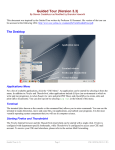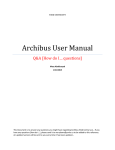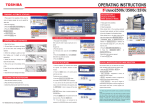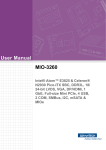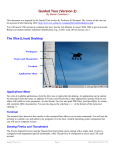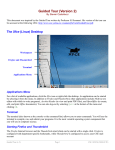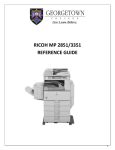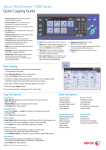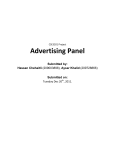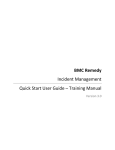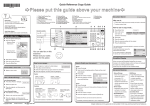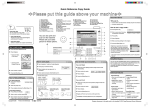Download Ricoh MP 5001 Reference Guide for Library staff
Transcript
Ricoh MP 5001 Reference Guide for Library staff Updated By: Remark: Helium Tsui Date: September 1, 2011 1. Manual is available at www.lcshelp.yorku.ca, Manual or User Guide, Printer Manual and User Guide, Ricoh MP 5001 Copier 2. If copier requires service due to mechanical, paper jam or toner problem / issue, please contact: Steve Tingey. 3. If network printing or scanner concern, please contact: [email protected] 1 Changing Modes The Ricoh MP 5001 can produce in a variety of modes. To toggle between the modes, use the equipment control panel on the front of the machine. The available modes are located on the left‐ hand side of the display screen. To switch between modes, press the appropriate button on the left. The display screen will change to the appropriate mode. • Copy Mode – Copies of original document are produced while in this mode. Place the original in the Automatic Document Handler/glass platen and follow the standard copy procedures (See Basic Copy Features). • Document Server Mode Documents can be copied, stored and printed with special features at a later date. • Scanner Mode - Documents can be sent via email or folder when the machine is in this mode. • Printer Mode – Documents can be sent to the 5001 from a personal computer for printing. Select this mode to print the documents from a computer. 2 Basic Copy Features 1. To make a copy, press the ‘Copy’ button located on the left hand side of the control panel. 2. Place your originals on the glass or in the automatic document feeder. Figure 1: Document is placed Face Up in the Document Feeder Figure 2: Document is placed Face Down on the Platen Glass 3. Make your desired setting selections from the display screen. A. Auto Paper Select – Available paper options are: Letter (8 ½ x 11), legal (8 ½ x 14), or ledger (11 x 17) B. Full Size – Enlarge/reduce the copy size as a percentage of the original document size. Set this to occur automatically by selecting the “Auto Reduce/Enlarge” button. Manual document enlargement/reduction can occur by selecting the appropriate document size available on the screen: ‘11 x17 > 8 ½ x 11’. Additional options can be accessed by selecting the ‘Reduce/Enlarge’ button located on the bottom right hand side of the screen. C. 2 – Sided Documents – Copy documents that have text written on both sides. Select the appropriate option for the document to be produced. Additional options are available and can be accessed by selecting the ‘Dup./Combine/Series’ button located on the bottom of the screen. D. Original Type Setting – Select the original document type to ensure a cleaner copy is produced. Text – Original document contains text only Photo – Original document was produced on color copier or contains only photographs Text/Photo - Original document contains photographs and text Generation Copy – if the original document is a copy, this option can be used to produce a clear and clean image. Pale – this option can be selected if the original document has pale lines or pencil marks that can be difficult to view when copied. E. Finishing Options – The stapling feature is included under this option. Sort – Copies are assembled in sequential order 3 Rotate Sort – Every other copy is rotated 90 degrees when delivered to the output tray. To use this ‘Rotate Sort’ feature, two paper trays must be loaded with the same size paper in a different orientation. Stack – Copies are grouped by page and shifted when delivered from the machine Staple – Copies are sorted and stapled together. Staple placement options are available and can be selected on the main display screen Punch – Copies are punched for binding. Additional punch placement options can be selected from the mail display screen Additional options can be chosen by selecting the ‘Finishing’ button located on the bottom of the screen. F. Auto Density – Adjust the darkness/lightness of the document based on the quality of the original 4. Using the keypad, enter the number of copies required and press ‘Start’. The display screen view can be adjusted to show the only most commonly used equipment options. To simply the main display screen select the ‘Simplified Display’ option next to the number keypad. 4 Paper Selection The paper select feature allows you to manually select the desired paper size for your copies. 1. Select ‘Paper Select’ on the basic copy interactive screen. 2. Select the appropriate paper size desired. Auto – Copy is the same size as the original. This is the default setting LTR – Copy is on 8 ½ x 11 paper, regardless of the size of the original LGL - Copy is on 8 ½ x 14 paper, regardless of the size of the original 11 x 17 – Copy is on 11 x 17 paper, regardless of the size of the original Bypass – The bypass tray found on the side of the copier allows for the use of special sized paper that does not fall into one of the above paper trays listed. Standard sized documents can also be fed through the bypass tray as well (Letterhead or color paper) 3. Enter the number of copies desired and press ‘Start’. Duplex This function enables you to make two-sided copies from one- or two-sided originals or one-sided copies from two-sided originals. Making Two-sided Copies from One- sided Originals (1 - 2 sided) - This feature enables you to make twosided copies from one-sided originals. 1. Select the desired option from the main display screen or select ‘Dup./Combine/Series’ on the interactive screen 2. Select ‘Duplex’ 3. Select ‘1 Sided →2 Sided’ and select ‘OK’ 4. Place the originals in the Automatic Document Feeder and press ‘Start’ Making Two-sided Copies from Two-sided Originals (2- 2 sided) – This feature enables you to copy two-sided originals on the front and back sides of the paper. 1. Select the desired option from the main display screen or select ‘Dup./Combine/Series’ on the interactive screen 2. Select ‘Duplex’ 3. Select ‘2 Sided →2 Sided’ and select ‘OK’ 4. Place the originals in the Automatic Document Feeder and press ‘Start’ 5 Finishing The finishing option will allow stapling of copy sets as they are produced. 1. Place the originals in the automatic document feeder and select ‘Finishing’ on the interactive screen. Your location may have optional finisher features on your equipment. Please refer to your Equipment User Manual for specific details on how to operate optional features not included in this section. 2. Select the desired staple or hole punch position from the available options. Available options may vary based on optional finisher features. 3. Place the originals, enter the desired number of copies and press ‘Start’. Print FeatureV The Ricoh MP 5001 can also be used as a black & white printer. You are able to access the print options directly from your computer. Accessing the 1HWZRUNPrintHU 1. Reference to document "Network Printer Installation for Staff Workstation" from www.lcshelp.yorku.ca, Helping tips for Application Software to install 2. select ‘Print’ from the ‘File’ drop down menu 3. In the Print dialog box, select the printer name from the Name drop down list. Click on ‘Properties’ ‘Printing Preferences’, to select any special printing options. 4. Specify the various print settings in the Properties dialog box. 6 5.To switch between sheets, click the tabs for the appropriate area – Basic, Paper, Edit, Finishing, .... Once the print settings are established, click ‘OK’ to begin printing 6. Select ‘OK’ to begin printing. 7. All the changes will not save after close the application(s) since this is network printer. Finishing Options The following is a summary of some of the available finishing features accessible through the print options of the Ricoh 5001. elect the available options from the display list. Collate – Sorted copies are produced. Staple – Copies are collated and stapled. Punch – Copies are 2 or 3 hole punched. 3. Once all finishing options have been made, select ‘OK’. 4. Enter the number of document copies desired. Select ‘OK’ to begin printing. Two-Sided Printing Duplex or two-sided printing occurs when the Ricoh produces documents with print on both sides of the paper. 1. The user can adjust the position of the document and margins to ensure all information is captured when producing the two-sided document. 2. Once all finishing options have been made, select ‘OK’. 3. Enter the number of document copies desired. Select ‘OK’ to begin printing. 7 Basic Scanning to Folder Features (not E-mail) Figure 1: Document is placed Face Up in the Document Feeder Figure 2: Document is placed Face Down on the Platen Glass 1. Set your originals and press the [Scanner] key. 2. Press [Department], the default file type is PDF. To change other format, press [File Name / Type]. 3. File name will be automatically assigned and started with date in department folder H:\PUBLIC\Temporary\Scanner\[Department]. To specify file name, press [File Name / Type], then press [File Name] 4. Press the [Start] key to scan 5. To scan multiple document into one file, must press the [Start] within 30 seconds. 6. Finish scan, press [#] or wait for 30 seconds to preview. Note Scanner Default Settings Scan Type: Auto Color Select If the document has colour on it, it is scanned has a colour document. Resolution: 300 DPI Larger DPI, larger file szie, better document/image quality. Scan Size: Auto 8 Press [File Name / Type] 1. File Type Settings are defaulted to PDF, can be changed to other format. 2. File name will be automatically assigned and started with date in department folder H:\PUBLIC\Temporary\Scanner\[Department]. 3. File Name can be specified, press [File Name]. 4. Press the [Start] key to scan Scanned File Preview 1. Press [Switch] to view next page. 2. Press [Send] to send document to server H:\PUBLIC\Temporary\Scanner\[Department]. 3. To scan another file, press [Department] to scan. 4. Press [Copy] to end scan 5. Copy the scanned file(s) to other location and delete it from the scanned folder H:\PUBLIC\Temporary\Scanner\[Department]. 9









